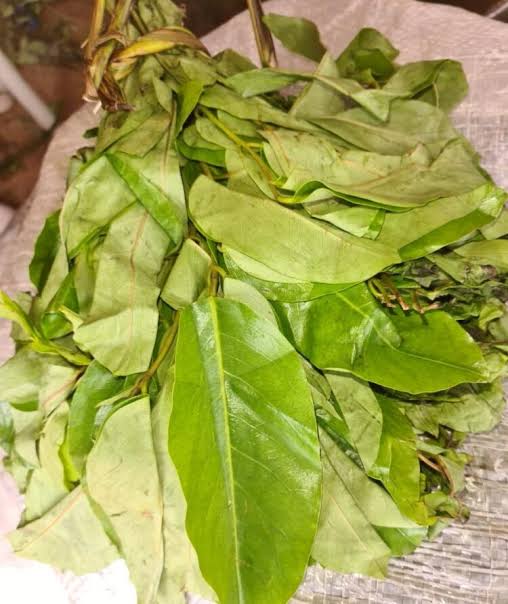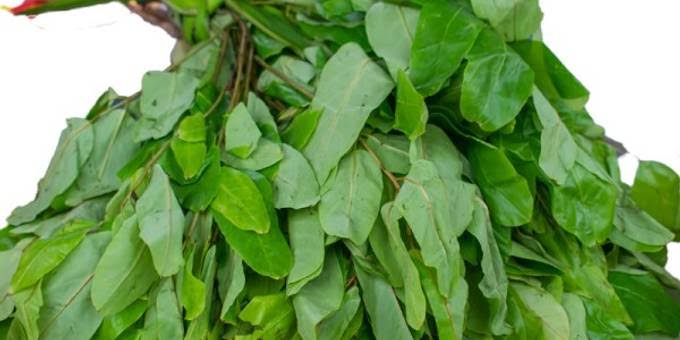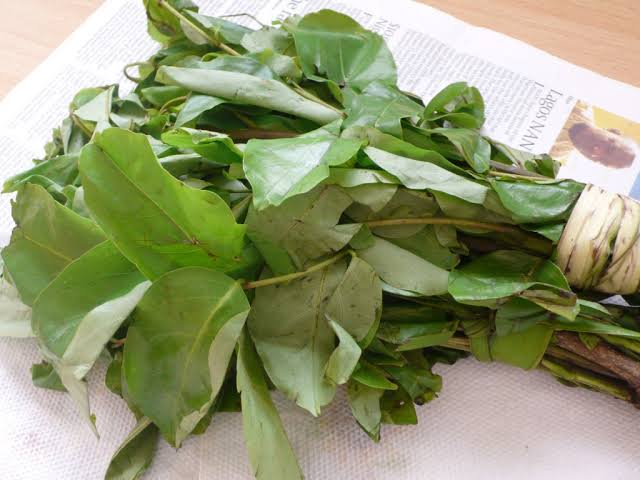Oha leaf, scientifically known as Pterocarpus mildbraedii, holds a unique place in West African culture, valued both as a culinary ingredient and as a source of nutrients. This leaf, widely cultivated in the tropical regions of Africa, is particularly popular in Nigerian cuisine, where it is often used in soups and other traditional dishes.
The soft, tender texture of Oha leaves, combined with their mildly earthy flavor, makes them an ideal component in a variety of recipes. However, their appeal extends far beyond flavor; Oha leaves are packed with an array of nutrients, making them a valuable food source for promoting health and wellness.
Oha leaves are rich in essential vitamins and minerals that support overall health. They contain a high concentration of vitamins, particularly vitamin C, which plays a critical role in maintaining immune health, promoting skin health, and supporting wound healing. Vitamin C, a powerful antioxidant, helps to protect the body from oxidative stress, a process that can damage cells and lead to chronic illnesses over time.
Oha leaves also contain a notable amount of vitamin A, another essential nutrient that supports immune function, maintains healthy skin, and is crucial for eye health. Vitamin A’s role in vision, particularly in preventing night blindness, underscores the importance of this leaf in areas where diets may otherwise lack adequate vitamin A sources.
Beyond vitamins, Oha leaves are an excellent source of minerals. Calcium, for instance, is present in significant amounts in Oha leaves. This mineral is essential for building and maintaining strong bones and teeth.
It is particularly important for children, pregnant women, and the elderly, who need extra calcium to support growth, bone density, and overall skeletal health. Additionally, Oha leaves contain iron, a vital component for producing hemoglobin in red blood cells, which is crucial for transporting oxygen throughout the body.
Iron deficiency can lead to anemia, a condition marked by fatigue, weakness, and shortness of breath, making Oha leaves a valuable addition to the diet for those at risk of anemia. The potassium content in Oha leaves also supports cardiovascular health by helping to regulate blood pressure, which is essential for preventing hypertension and reducing the risk of heart disease.
Oha leaves are also valued for their high fiber content. Dietary fiber is essential for digestive health, as it helps regulate bowel movements, reduces constipation, and supports a healthy gut microbiome by acting as a prebiotic.
The fiber in Oha leaves helps to slow digestion, leading to a more gradual release of glucose into the bloodstream. This process can be particularly beneficial for individuals with diabetes or those looking to maintain stable blood sugar levels, as it prevents sharp spikes and dips in glucose levels.
Moreover, fiber has been shown to support weight management by promoting a feeling of fullness, which can help reduce overall calorie intake. This combination of digestive health support and potential weight management benefits makes Oha leaves a well-rounded choice for those focused on maintaining a healthy diet.
Antioxidants are another significant component of Oha leaves, contributing to their nutritional profile and health benefits. Antioxidants are compounds that help neutralize free radicals in the body, unstable molecules that can cause cellular damage when their levels become too high.
This oxidative damage is linked to chronic diseases such as cancer, heart disease, and age-related degenerative conditions. The antioxidants in Oha leaves, including vitamin C and other plant-based compounds, help protect the body from these harmful effects, supporting longevity and overall health.
In addition to the primary vitamins, minerals, and antioxidants, Oha leaves contain secondary metabolites that offer additional health benefits. These compounds include flavonoids and alkaloids, which are known for their anti-inflammatory and antimicrobial properties.
The anti-inflammatory properties of these compounds can be beneficial in managing conditions characterized by chronic inflammation, such as arthritis. By reducing inflammation in the body, Oha leaves may help alleviate symptoms like pain and swelling associated with these conditions.
The antimicrobial properties of the leaf are traditionally used in some cultures to address minor infections and may offer support for the immune system in resisting pathogens.
Oha leaves also hold cultural significance, especially in traditional medicine, where they are utilized for their health-promoting properties. In various African communities, Oha leaves are often incorporated into remedies aimed at strengthening the immune system, alleviating digestive issues, and promoting general well-being.
They are sometimes used in teas, infusions, or other herbal preparations to support the body’s natural defenses. Although modern science is still exploring the full scope of these traditional practices, the cultural knowledge surrounding Oha leaves highlights their long-standing value in health and wellness.
For pregnant women, Oha leaves offer an additional set of benefits. The nutritional value of these leaves supports both the mother and the developing fetus. The high content of folate, an essential B-vitamin, is particularly important during pregnancy.
Folate is critical for the proper development of the fetal nervous system and can help prevent neural tube defects. The calcium content also supports fetal bone development and strengthens the mother’s bones, which can be taxed during pregnancy.
Additionally, the iron in Oha leaves helps prevent anemia, which is common during pregnancy due to the increased demand for red blood cells. These combined benefits make Oha leaves a valuable food for expectant mothers looking to support a healthy pregnancy.
Oha leaves are a versatile and nutritious option for individuals seeking to enhance their diet with plant-based nutrients. They can be incorporated into various dishes, from traditional soups to more contemporary recipes, allowing for flexibility in their use.
Their mild flavor complements a range of ingredients, making them an easy addition to many types of meals. For those interested in whole, natural foods, Oha leaves offer a nutrient-dense choice that supports overall health and wellness.
Read Also: Types of Flowers
Medicinal Uses and Benefits of Oha Leaf

1. Supports Digestive Health: One of the most noted traditional uses of Oha leaf is in the area of digestive health. Rich in dietary fiber, Oha leaf aids in promoting regular bowel movements, which is essential for a well-functioning digestive system. Fiber helps prevent constipation by adding bulk to the stool and promoting healthy bowel function.
Additionally, the fiber in Oha leaf acts as a prebiotic, feeding the beneficial bacteria in the gut. A balanced gut microbiome is essential for digestion, immunity, and even mental well-being. The leaf is often used in herbal remedies to alleviate stomachaches and digestive discomfort, as well as to treat diarrhea in some cultures.
2. Immune-Boosting Properties: Oha leaf has long been valued for its ability to strengthen the immune system. This is largely due to its high vitamin and antioxidant content, particularly vitamins A and C. Vitamin A is essential for maintaining the integrity of mucous membranes in the respiratory and digestive tracts, which are critical barriers against pathogens.
Vitamin C, on the other hand, stimulates the production of white blood cells and protects immune cells from oxidative damage, enhancing the body’s ability to ward off infections.
The antioxidants in Oha leaf also neutralize harmful free radicals, protecting cells from damage that could otherwise lead to chronic diseases and inflammation. Regular consumption of Oha leaf can thus provide natural support for immune health, potentially reducing the risk of common illnesses like colds and flu.
3. Anti-Inflammatory Benefits: In traditional medicine, Oha leaf is often used to manage inflammatory conditions, such as arthritis. This is due to the presence of anti-inflammatory compounds that help reduce inflammation in the body. Chronic inflammation is linked to a range of health issues, including heart disease, diabetes, and certain cancers.
By incorporating Oha leaf into one’s diet, individuals may be able to mitigate some of the effects of inflammation, thereby reducing pain and discomfort associated with inflammatory conditions. For people with joint pain or stiffness, Oha leaf may serve as a natural, supportive remedy that complements other treatments.
4. Promotes Cardiovascular Health: Oha leaf has shown potential in supporting heart health due to its potassium and fiber content. Potassium is a mineral that plays a critical role in regulating blood pressure by counteracting the effects of sodium.
Consuming potassium-rich foods, like Oha leaf, can help lower the risk of hypertension and, by extension, reduce the likelihood of cardiovascular events such as strokes or heart attacks.
The fiber in Oha leaf also contributes to cardiovascular health by reducing cholesterol levels, particularly low-density lipoprotein (LDL) cholesterol, often referred to as “bad” cholesterol. High fiber intake is associated with improved lipid profiles, which translates to a healthier heart and vascular system.
5. Blood Sugar Regulation: The fiber in Oha leaf can also aid in managing blood sugar levels, making it beneficial for individuals with diabetes or those at risk of developing the condition. Fiber slows the absorption of glucose in the bloodstream, preventing rapid spikes and crashes in blood sugar.
For those dealing with blood sugar management issues, the leaf offers a natural, supportive solution that helps maintain energy levels and reduces the risk of insulin resistance.
While more research is needed to fully understand its effects on blood sugar regulation, Oha leaf is becoming an increasingly popular choice in natural therapies for diabetes support.
6. Bone and Joint Health: The high calcium content in Oha leaf is especially beneficial for bone health. Calcium is vital for building and maintaining strong bones, which is particularly important as one ages.
For individuals at risk of osteoporosis, incorporating calcium-rich foods into the diet is essential. Magnesium, another mineral found in Oha leaf, works synergistically with calcium to strengthen bones and support joint health.
Together, these minerals provide a robust foundation for maintaining bone density, preventing fractures, and ensuring mobility in older age. For traditional healers, Oha leaf has long been recommended for those needing extra support in bone and joint health.
7. Skin Health and Anti-Aging Benefits: Oha leaf is rich in antioxidants, including vitamins A and C, which are known to support skin health. Vitamin A helps in skin cell regeneration, making it valuable for skin renewal and healing.
This can lead to smoother, healthier-looking skin and potentially reduce the appearance of fine lines and wrinkles. Vitamin C, on the other hand, supports collagen formation, which is necessary for skin elasticity.
The antioxidants in Oha leaf also combat oxidative stress, which is a significant contributor to premature aging. By protecting skin cells from damage, Oha leaf can help maintain a youthful appearance, making it a valuable component in anti-aging practices.
8. Weight Management: The fiber in Oha leaf can also aid in weight management by promoting feelings of fullness and reducing overeating. Fiber takes longer to digest, which helps regulate hunger and maintain steady energy levels.
By slowing down digestion, fiber prevents rapid spikes in blood sugar and insulin, which can contribute to fat storage. People looking to manage their weight may find Oha leaf a helpful addition to their diet, as it supports satiety and may reduce calorie intake over time. Its low-calorie content combined with high fiber makes it ideal for those aiming to maintain or achieve a healthy weight.
9. Liver Health and Detoxification: In traditional medicine, Oha leaf is sometimes used to support liver function and detoxification. The liver plays a central role in filtering toxins from the body, and maintaining its health is essential for overall well-being. Oha leaf is believed to assist in liver detoxification, helping to clear out toxins and support the organ’s ability to process and eliminate waste.
This may be particularly useful for individuals exposed to environmental toxins or those looking to support their liver health. While modern scientific research on this benefit is still developing, the traditional use of Oha leaf as a liver tonic has remained consistent across cultures.
10. Potential Cancer-Preventive Properties: Due to its high antioxidant content, Oha leaf may also offer protective benefits against certain types of cancer. Antioxidants help reduce oxidative stress, a factor linked to the development of cancer.
By neutralizing free radicals, antioxidants in Oha leaf protect cells from DNA damage, which is a key step in cancer prevention. Although research in this area is still emerging, traditional healers have long used Oha leaf as part of a broader approach to support health and longevity.
Read Also: Flower Cultivation Techniques
Culinary Uses of Oha Leaf

Oha leaf, derived from the Pterocarpus mildbraedii tree, is a cherished ingredient in West African cuisine, particularly among the Igbo people of Nigeria. Renowned for its unique flavor, vibrant color, and numerous health benefits, Oha leaf has become a staple in many traditional dishes. This article explores the various culinary uses of Oha leaf, highlighting its versatility and significance in cooking.
1. Oha Soup: One of the most popular dishes featuring Oha leaf is Oha soup, a traditional delicacy among the Igbo community. Oha soup is known for its rich and hearty flavor, often made with assorted meats, fish, and local spices. The leaves are typically added toward the end of cooking to preserve their vibrant color and nutritional value.
The soup is thickened with ground seeds, such as cocoyam or achi, creating a creamy texture that complements the richness of the meat and broth. Oha soup is often served with fufu, a starchy side dish made from cassava, yams, or plantains, providing a satisfying and balanced meal.
2. Incorporation in Stews and Sauces: Oha leaves can also be used in various stews and sauces, adding a unique flavor profile to dishes. When chopped and added to tomato-based stews or vegetable sauces, Oha leaf enhances the overall taste, contributing a subtle earthiness that pairs well with other ingredients.
It can be used alongside meats, fish, and legumes, making it a versatile addition to many recipes. The leaf’s texture holds up well in cooking, providing a pleasant mouthfeel that complements the dish.
3. Oha Leaf Salad: For those seeking a lighter option, Oha leaf can be enjoyed fresh in salads. The leaves can be mixed with other greens, such as lettuce or spinach, and topped with a simple dressing of olive oil, lemon juice, and spices.
This refreshing salad not only retains the nutritional benefits of the leaves but also offers a different way to experience their unique flavor. Adding other ingredients, such as sliced tomatoes, cucumbers, and avocados, can enhance the salad’s nutritional profile and visual appeal.
4. Flavoring Rice and Grain Dishes: In addition to soups and stews, Oha leaves can be used to flavor rice and grain dishes. By finely chopping the leaves and mixing them into rice or jollof rice, they infuse the grains with a delightful herbal aroma and flavor. Oha leaf can also be added to couscous, quinoa, or other grains, enhancing their taste and providing additional nutrients. This method of incorporation allows home cooks to experiment with different types of grains while enjoying the benefits of Oha leaf.
5. Smoothies and Juices: For those interested in incorporating Oha leaf into their diet in a more unconventional way, it can be added to smoothies and juices. Blending Oha leaves with fruits like bananas, mangoes, and pineapples creates a nutritious and flavorful drink.
This method preserves the leaf’s vitamins and minerals while making it an easy addition to a busy lifestyle. The natural sweetness of the fruits helps mask the earthy flavor of the leaves, making it a delicious option for those who may be hesitant to try them otherwise.
6. Traditional Medicinal Uses in Cooking: In addition to its culinary applications, Oha leaf is recognized for its medicinal properties, and these can be highlighted in various dishes. For instance, when preparing soups or stews for medicinal purposes, Oha leaves can be included as a functional ingredient to promote health and well-being.
Traditional beliefs suggest that consuming Oha leaf can help boost the immune system and support overall health, making it a valuable addition to meals prepared for those recovering from illness or seeking to enhance their well-being.
7. Infusion in Broths: Oha leaves can be used to infuse flavors in broths or stock, enhancing the overall taste of the liquid base used for soups or sauces. By adding whole leaves to simmering stock or broth, the leaves impart their unique flavor and nutrients, creating a rich and aromatic base. This method is especially useful for vegetarian or vegan dishes, where the depth of flavor is essential for creating satisfying meals.
8. Drying and Storage: For those who may not have access to fresh Oha leaves year-round, drying is a practical method of preservation. Dried Oha leaves can be stored and used in cooking as needed, maintaining their flavor and nutritional benefits.
When dried, the leaves can be crumbled and added to various dishes, much like dried herbs. This allows for the continued use of Oha leaves in the kitchen, even when fresh varieties are not available.
9. Pairing with Other Ingredients: Oha leaves pair well with a variety of ingredients, making them an excellent addition to diverse culinary creations. They complement proteins like chicken, beef, and fish, as well as plant-based options such as beans and lentils.
Incorporating Oha leaves with other vegetables, spices, and herbs can elevate the flavors in a dish, creating a harmonious balance that enhances the overall dining experience.
10. Cultural Significance: The use of Oha leaf extends beyond its culinary attributes; it is deeply rooted in cultural practices and traditions. In many communities, Oha leaf is associated with family gatherings, celebrations, and rituals.
The preparation and sharing of dishes featuring Oha leaf often symbolize unity and togetherness, making it an essential component of communal meals. Understanding the cultural significance of Oha leaf adds depth to its culinary uses, emphasizing its importance in both flavor and tradition.
Frequently Asked Questions on the Uses and Benefits of Oha Leaf

1. What is Oha leaf?
Oha leaf, derived from the Pterocarpus mildbraedii tree, is a popular green leafy vegetable in West African cuisine, particularly in Nigeria. It is known for its unique flavor and is commonly used in traditional dishes like Oha soup.
2. What are the nutritional benefits of Oha leaf?
Oha leaf is rich in vitamins A and C, minerals such as calcium and iron, and dietary fiber. These nutrients contribute to overall health, support the immune system, and promote good digestion.
3. How is Oha leaf typically used in cooking?
Oha leaf is primarily used in soups and stews, such as Oha soup. It can also be incorporated into salads, rice dishes, smoothies, and traditional snacks, providing a unique flavor and nutritional boost.
4. Can Oha leaf be consumed raw?
Yes, Oha leaf can be eaten raw in salads or as a garnish. However, it is commonly cooked to enhance its flavor and make it more palatable.
5. Are there any health benefits associated with consuming Oha leaf?
Yes, consuming Oha leaf may offer various health benefits, including anti-inflammatory properties, improved digestion, and support for overall well-being. It is also believed to boost the immune system.
6. How do you store Oha leaves?
Fresh Oha leaves should be stored in a cool, dry place, preferably in the refrigerator, to maintain their freshness. If you have excess leaves, you can dry them for later use in cooking.
7. Can Oha leaf be used for medicinal purposes?
Traditionally, Oha leaf has been used in various medicinal applications. It is believed to have healing properties and may help with ailments such as digestive issues and inflammation.
8. How can I incorporate Oha leaf into my diet?
You can add Oha leaf to soups, stews, salads, rice dishes, and smoothies. Experimenting with different recipes can help you discover new and delicious ways to enjoy this nutritious leafy green.
Read Also: Everything You Need To Know About Apple Fitness
Do you have any questions, suggestions, or contributions? If so, please feel free to use the comment box below to share your thoughts. We also encourage you to kindly share this information with others who might benefit from it. Since we can’t reach everyone at once, we truly appreciate your help in spreading the word. Thank you so much for your support and for sharing!






